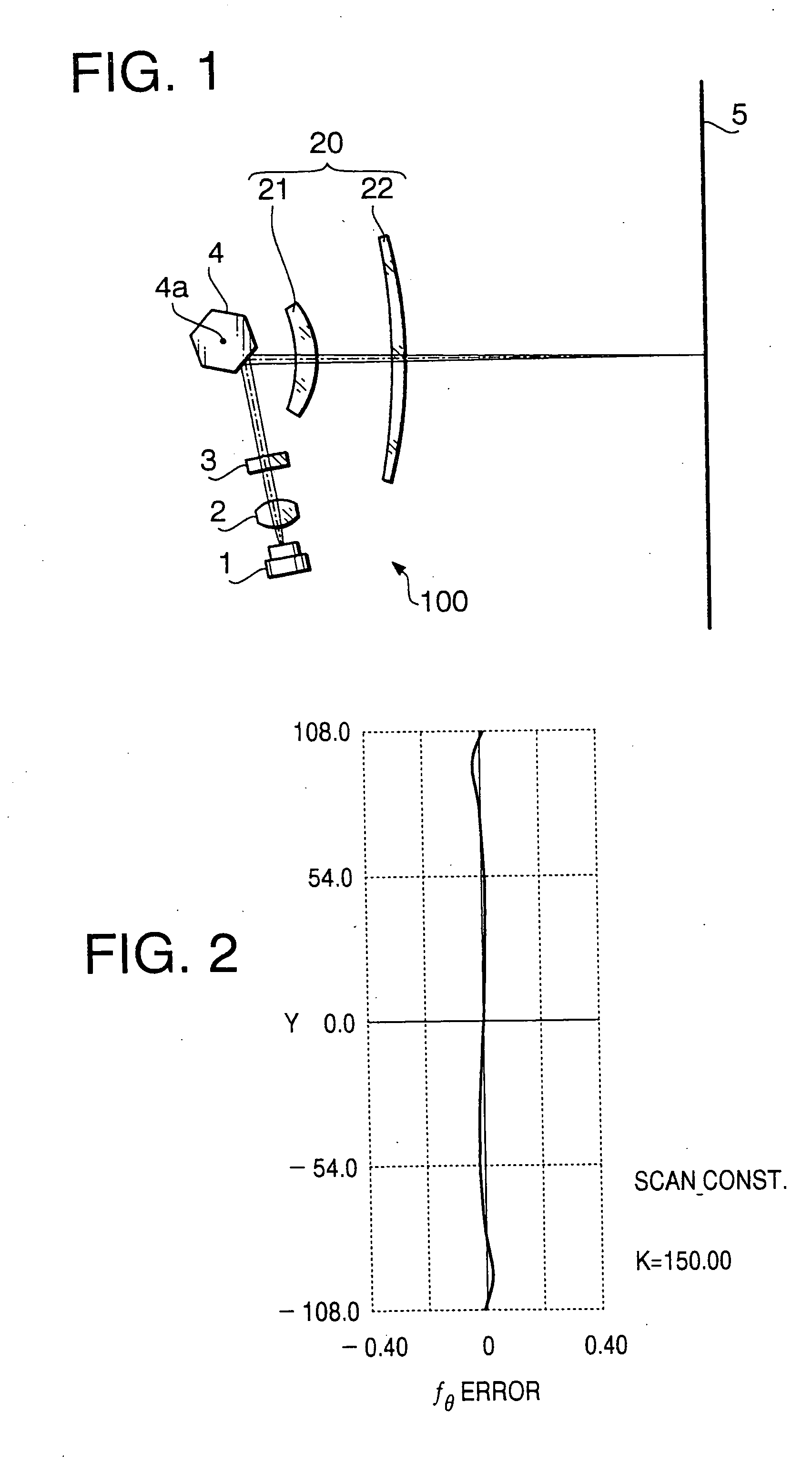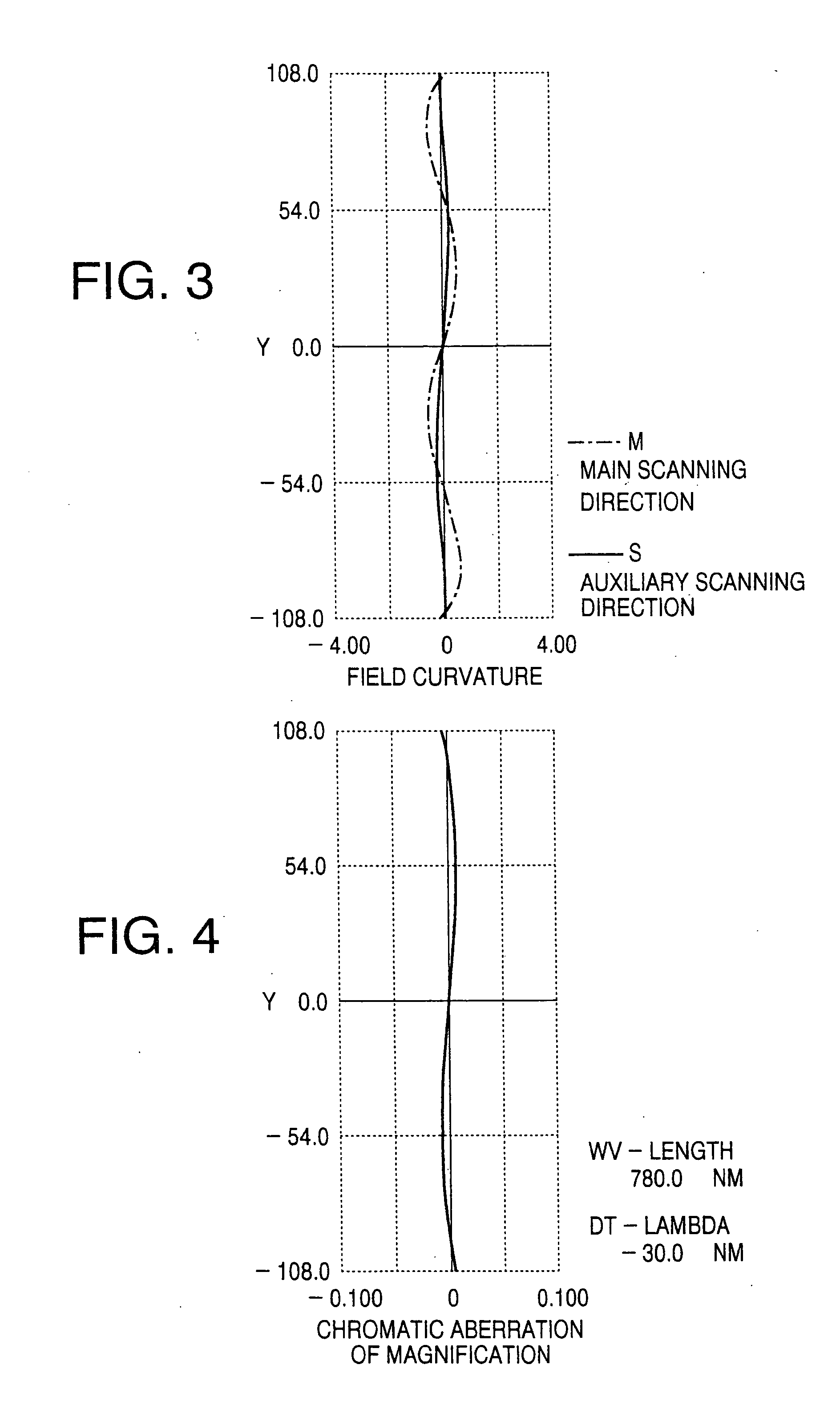Scanning optical system
a scanning optical and optical system technology, applied in the field of scanning optical systems, can solve the problems of deterioration of image formation precision, fluctuation of scan lines formed on the image formation surface, loss of shape, etc., and achieve the effect of reducing the deterioration of diffraction efficiency
- Summary
- Abstract
- Description
- Claims
- Application Information
AI Technical Summary
Benefits of technology
Problems solved by technology
Method used
Image
Examples
first example
[0044] A scanning optical system as a first example of this embodiment is designed assuming that the wavelength of the laser beam emitted by the laser diode 1 is 780 nm. The focal length f of the fθ lens 20 regarding the main scanning direction is 150 mm, and the effective scan width W of the scanning optical system on the image formation surface is 216 mm. The polygon mirror 4 has six reflecting surfaces with an inscribed radius (the radius of the inscribed circle of the polygon) of 12.1 mm. The angle of the laser beam incident upon the polygon mirror 4 with respect to the optical axis of the fθ lens 20 is −80.0 degrees (“−”denotes the clockwise direction in FIG. 1).
[0045] The following Table 1 shows the configuration of each optical surface of the scanning optical system of the first example between the cylindrical lens 3 and the image formation surface 5. In the table, the symbol “R” denotes a curvature radius (mm) of each optical surface in the main scanning direction, “Rz” den...
second example
[0058] Similarly to the first example described above, a scanning optical system as a second example of this embodiment is designed assuming the wavelength 780 nm of the laser beam emitted by the laser diode 1. The focal length f of the fθ lens 20 regarding the main scanning direction is 150 mm, and the effective scan width W of the scanning optical system on the image formation surface is 216 mm. The polygon mirror 4 has six reflecting surfaces with an inscribed radius of 12.1 mm. The angle of the laser beam incident upon the polygon mirror 4 with respect to the optical axis of the fθ lens 20 is −80.0 degrees (“−”denotes the clockwise direction in FIG. 1).
[0059] The following Table 4 shows the configuration of each optical surface of the scanning optical system of the second example between the cylindrical lens 3 and the image formation surface 5. The meaning of each symbol in Table 4 is the same as that in Table 1.
TABLE 4No.RRzDn(780 nm)n(750 nm)#1∞33.204.001.51071.5107#2∞62.36...
third example
[0063] Similarly to the first and second examples described above, a scanning optical system as a third example of this embodiment is designed assuming the wavelength 780 nm of the laser beam emitted by the laser diode 1. The focal length f of the fθ lens 20 regarding the main scanning direction is 150 mm, and the effective scan width W of the scanning optical system on the image formation surface is 216 mm. The polygon mirror 4 has six reflecting surfaces with an inscribed radius of 12.1 mm. The angle of the laser beam incident upon the polygon mirror 4 with respect to the optical axis of the fθ lens 20 is −80.0 degrees (“−”denotes the clockwise direction in FIG. 1).
[0064] The following Table 7 shows the configuration of each optical surface of the scanning optical system of the third example between the cylindrical lens 3 and the image formation surface 5. The meaning of each symbol in Table 7 is the same as that in Table 1.
TABLE 7No.RRzDn(780 nm)n(750 nm)#1∞33.204.001.51071.51...
PUM
 Login to View More
Login to View More Abstract
Description
Claims
Application Information
 Login to View More
Login to View More - R&D
- Intellectual Property
- Life Sciences
- Materials
- Tech Scout
- Unparalleled Data Quality
- Higher Quality Content
- 60% Fewer Hallucinations
Browse by: Latest US Patents, China's latest patents, Technical Efficacy Thesaurus, Application Domain, Technology Topic, Popular Technical Reports.
© 2025 PatSnap. All rights reserved.Legal|Privacy policy|Modern Slavery Act Transparency Statement|Sitemap|About US| Contact US: help@patsnap.com



